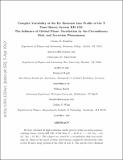| dc.contributor.author | Hamilton, Catrina M. | |
| dc.contributor.author | Johns-Krull, Christopher M. | |
| dc.contributor.author | Mundt, Reinhard | |
| dc.contributor.author | Herbst, William | |
| dc.contributor.author | Winn, Joshua Nathan | |
| dc.date.accessioned | 2013-09-19T18:48:39Z | |
| dc.date.available | 2013-09-19T18:48:39Z | |
| dc.date.issued | 2012-05 | |
| dc.date.submitted | 2012-01 | |
| dc.identifier.issn | 0004-637X | |
| dc.identifier.issn | 1538-4357 | |
| dc.identifier.uri | http://hdl.handle.net/1721.1/80810 | |
| dc.description | Author Manuscript 5 Apr 2012 | en_US |
| dc.description.abstract | We have obtained 48 high-resolution echelle spectra of the pre-main-sequence eclipsing binary system KH 15D (V582 Mon, P = 48.37 days, e ~ 0.6, M[subscript A] = 0.6 M [subscript ☉], MB = 0.7 M [subscript ☉]). The eclipses are caused by a circumbinary disk (CBD) seen nearly edge on, which at the epoch of these observations completely obscured the orbit of star B and a large portion of the orbit of star A. The spectra were obtained over five contiguous observing seasons from 2001/2002 to 2005/2006 while star A was fully visible, fully occulted, and during several ingress and egress events. The Hα line profile shows dramatic changes in these time series data over timescales ranging from days to years. A fraction of the variations are due to "edge effects" and depend only on the height of star A above or below the razor sharp edge of the occulting disk. Other observed variations depend on the orbital phase: the Hα emission line profile changes from an inverse P-Cygni-type profile during ingress to an enhanced double-peaked profile, with both a blue and a red emission component, during egress. Each of these interpreted variations are complicated by the fact that there is also a chaotic, irregular component present in these profiles. We find that the complex data set can be largely understood in the context of accretion onto the stars from a CBD with gas flows as predicted by the models of eccentric T Tauri binaries put forward by Artymowicz & Lubow, Günther & Kley, and de Val-Borro et al. In particular, our data provide strong support for the pulsed accretion phenomenon, in which enhanced accretion occurs during and after perihelion passage. | en_US |
| dc.language.iso | en_US | |
| dc.publisher | IOP Publishing | en_US |
| dc.relation.isversionof | http://dx.doi.org/10.1088/0004-637x/751/2/147 | en_US |
| dc.rights | Creative Commons Attribution-Noncommercial-Share Alike 3.0 | en_US |
| dc.rights.uri | http://creativecommons.org/licenses/by-nc-sa/3.0/ | en_US |
| dc.source | arXiv | en_US |
| dc.title | Complex Variability of the Hα Emission Line Pro le of the T Tauri Binary System KH 15D: The In uence of Orbital Phase, Occultation by the Circumbinary Disk, and Accretion Phenomenae | en_US |
| dc.type | Article | en_US |
| dc.identifier.citation | Hamilton, Catrina M., Christopher M. Johns-Krull, Reinhard Mundt, William Herbst, and Joshua N. Winn. COMPLEX VARIABILITY OF THE Hα EMISSION LINE PROFILE OF THE T TAURI BINARY SYSTEM KH 15D: THE INFLUENCE OF ORBITAL PHASE, OCCULTATION BY THE CIRCUMBINARY DISK, AND ACCRETION PHENOMENA. The Astrophysical Journal 751, no. 2 (June 1, 2012): 147. | en_US |
| dc.contributor.department | Massachusetts Institute of Technology. Department of Physics | en_US |
| dc.contributor.mitauthor | Winn, Joshua Nathan | en_US |
| dc.relation.journal | The Astrophysical Journal | en_US |
| dc.eprint.version | Author's final manuscript | en_US |
| dc.type.uri | http://purl.org/eprint/type/JournalArticle | en_US |
| eprint.status | http://purl.org/eprint/status/PeerReviewed | en_US |
| dspace.orderedauthors | Hamilton, Catrina M.; Johns-Krull, Christopher M.; Mundt, Reinhard; Herbst, William; Winn, Joshua N. | en_US |
| dc.identifier.orcid | https://orcid.org/0000-0002-4265-047X | |
| mit.license | OPEN_ACCESS_POLICY | en_US |
| mit.metadata.status | Complete | |
